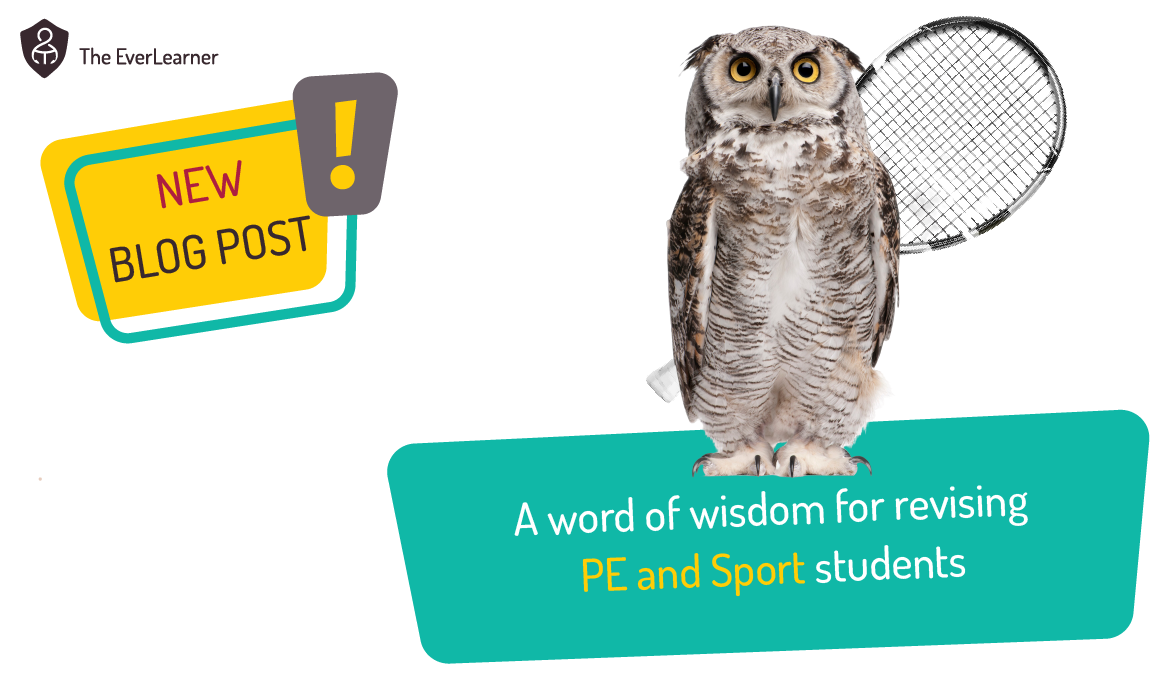Dear AQA GCSE PE students, this is how to ace your Paper 1 exam
Dear AQA GCSE PE student,
Yes, you! The one reading this post. I wanted to ask for a few moments of your time in order to share with you a few ideas about how to really prepare sharply for your Paper 1 exam.
The AQA GCSE PE paper 1 is a toughie. You know this already but, when rendered down into core elements, it’s really, really achievable.
The aim of this post is to give you 10 ideas that you can use to prepare better for your exam. Follow these guidelines as part of a thorough revision experience and I am confident you will fly.
My 10 top tips:
- Practise lots and lots of two and four-markers.
- Learn the command terms and what they mean.
- Be prepared to explain.
- Use the E-I-O method when making examples.
- Know components of fitness’, fitness testing’ and methods of training inside out.
- Use the TEL planning documents for your six- and nine-mark answers.
- Choose your synoptic links ahead of time.
- Complete and mark the National Mock Exam.
- Learn my model answers.
- Attend my revision sessions in May.
You will notice that none of these top tips involve common sense advice such as eating well, exercising regularly and getting enough sleep. You don’t need me to tell you these things. Instead, we’ll be focussing on the key behaviours that lead to success.
Top Tip #1 Practise lots and lots of two- and four-markers.
Well, this one is pretty obvious. Two and four-mark questions make up approaching half of the marks on an AQA GCSE PE Paper 1 exam. Take a look at this graph:

On average, 35 raw marks come from two- and four-mark questions. If we consider one-markers as being the most accessible questions, this means that of questions with a value greater than one mark, two and four-markers represent 55% of the marks from more challenging questions.
Therefore, there is nothing more impacting that you can do in order to prepare for your Paper 1 exam than to practise writing and marking two- and four-mark questions.
There are hundreds of examples available for you to practise on. If you do not already have access to ExamSimulator via TheEverLearner.com, speak to your teacher about this. Within this system, there are hundreds of two- and four-markers for you to engage with.
Top Tip #2 Learn the command terms and what they mean.
It is so easy to think of your exams as testing your knowledge. Well, they do, of course. But your exams (and, in this case, your AQA GCSE PE Paper 1 exam) also test your skills.
Take a look here:
.webp?width=450&height=414&name=image12%20(1).webp)
And here:
.webp?width=650&height=384&name=image1%20(1).webp)
The skills that you need to perform have a degree of consistency. Identify (often for one mark) is obvious but take a look at explaining and justifying. If you are able to really understand the requirements of these skills, you are going to develop an excellent advantage.
So, what do these skills actually mean? Take a look at the table below and start to think about how to respond when asked to develop each different skill. I also encourage you to highlight the skills that appear most commonly on AQA GCSE PE Paper 1 exams.
.webp?width=850&height=1030&name=image11%20(1).webp)
Top Tip #3 Be prepared to explain.
As you can see above, explaining is a key skill. AQA consider that explaining means:
In other words, you need to be able to state “how?” and/or “why?” for every single topic on the course. Simply knowing a definition or being able to describe a concept will, within explain responses, not be enough.
Let’s take an example. Let’s say I get two different questions about the same topic. The answers to each question are completely different. Let’s have a go:
Now, if I changed Q2 to “Explain how James blogs”, can you see how the answer would change? Do you agree that we may need to talk about my use of English, my computer, my website and even processes such as getting the articles proofread and a graphic designer making the imagery? Can you see that my answer is specific to the question posed? You need to do this.
If you are asked to explain, which you will be, you must explain! Here’s some language that you should use in your explain responses:
| Explain why... | Explain how... |
| because | through |
| this means | by |
| as a result | via |
| therefore | as a result of |
| the reason for this | caused by |
Just like you prepare for your knowledge, you need to prepare for your skills. I will take this further below.
Top Tip #4 Use the E-I-O method when making examples.
AO2 skills (otherwise known as making examples) is the second biggest feature of a successful AQA GCSE PE Paper 1 performance:
.webp?width=450&height=581&name=image3%20(1).webp)
On average, 26 marks come from making examples effectively. Therefore, you need to prepare for this and I encourage you to use the E-I-O method. Thankfully this is nice and simple:
.webp?width=850&height=133&name=image13%20(1).webp)
When you make your example, you MUST state the impact and the outcome of the concept on the example. Let’s take our own example:

Our author has clearly stated what the example is (dribbling), has stated the impact of the concept/agility and has gone on to state the outcome of the concept. This is the standard I urge you to achieve when making your own examples.
Let’s look at another example from Paper 1:
.webp?width=650&height=385&name=image2%20(1).webp)
In this response, the entire answer is applied to the example using the E-I-O method.
Teachers and students wishing to study the E-I-O method in more detail should visit 100 Practical Examples Part 1, 100 Practical Examples Part 2 and 100 Practical Examples Part 3 of my writing on this topic.
Top Tip #5 Know components of fitness, fitness testing and methods of training inside out.
How can I put this without being accused of predicting your 2023 paper? I guess the only way I can say it is that, by some margin, components of fitness, fitness testing and methods of training have been the most heavily examined topics between 2018 and 2022.

Therefore, only a fool would not have these topics absolutely nailed down in preparation for their exam in 2023.
Let’s take them in turn:
.webp?width=850&height=299&name=image6%20(1).webp)
We know the following about components of fitness:
- It has been examined every year so far with substantial marks available on every paper.
- Most marks from this topic come from AO2 and AO3.
- Being able to justify the importance of components of fitness to different activities is critical.
So, guess what? This topic and these skills are going to be a central feature of my revision sessions (see tip 10) in May.

We know the following about fitness testing:
- Like ‘components of fitness, fitness testing has featured on every paper between 2018 and 2022.
- A balanced range of skills is required alongside fitness testing but students need to be prepared for AO3 skills including evaluating and discussing.

We know the following about methods of training:
- Like components of fitness and fitness testing, methods of training have featured on every paper between 2019 and 2022.
- Like fitness testing, plenty of AO3 marks can be acquired using the evaluate and discuss skills.
So, in summary, whilst there are no guarantees about what might appear on a 2023 exam paper, preparing for these three topics diligently and with the key skills in mind is a very good investment of your revision time.
With this in mind, I urge you to take part in my utterly free Paper 1 revision in May.
Top Tip #6 Use the TEL planning documents for your six and nine-mark answers.
As you will probably already know, you will answer a six-mark and nine-mark extended writing piece in your AQA GCSE PE Paper 1 exam. Whilst it is true that two- and four-markers carry more total raw marks, it’s really useful to become competent at answering these questions because it is the exact area where most students perform less well. Therefore, if you want to mark yourself out and get a better mark than others taking your paper, extended writing is an excellent way to do so:

As you can see from this image, most students fail to achieve most of the marks on six- and nine-mark questions and, if you manage to do so, you can really push ahead of the field.
In order to do that, I strongly recommend that you use my preparation documents. There are versions for both the six-mark writing and nine-mark writing and using these resources in preparation for your exam will serve you very well.
If you are a teacher and are wondering about the best use of these resources, you can watch a webinar I broadcast a few weeks ago here.
Top Tip #7 Choose your synoptic links ahead of time.
Your nine-mark, extended writing answer requires you to make synoptic links from your answer to the question posed to other areas of content across the AQA GCSE PE course.
I highly recommend that you have a series of synoptic links ready ahead of time and to support you with this, I have written this document:
.webp?width=596&height=842&name=image5%20(1).webp) Click to download a file for your folder
Click to download a file for your folder
I recommend making a minimum of two synoptic links in your nine-mark answer but, ideally, three. Some students make more. The document above will give you all the information you need to make these links within your answer.
Top Tip #8 Complete and mark the National Mock Exam.
As I think you can probably tell, I think about how to perform well on AQA GCSE PE Paper 1 quite a lot. All of my thinking has been put into writing a highly relevant National Mock Exam paper which I published in January 2023. I urge you to speak to your teacher and ask them to download this paper and mark scheme, and to give you the opportunity to answer it, ideally under assessment conditions, before marking it using the mark scheme.
There is quite literally no better preparation for your exam that you can do.
Top Tip #9 Learn my model answers.
On April 28th, I’ll be publishing my model answers to the National Mock Exam for everyone to download and read. I am going to make a very fundamental point about them here: LEARN THE MODEL ANSWERS. I mean, really now, please learn them. The model answers are hyper-relevant to your exam experience this summer and represent the ideal ways to answer all kinds of questions including the skills discussed in many of the points above.
Please, please, please, learn those answers. You will not regret one second of doing so.
Top Tip #10 Attend my revision sessions in May.
And finally… a very, very simple message: I will be broadcasting my live revision show based on all the points made above on Wednesday 3rd May, exactly two weeks before your exam on the 17th.
Folks, I cannot make this clearer: Be there! Whilst I can’t promise you entertainment like Netflix or giggles like going out with your mates, I can guarantee you that this session is delivered with everything I am and will help you massively in your preparations for the exam itself. The revision is utterly free and comes with an entire notes pack as well as the previously published infographics, mock exam, mark scheme and model answers.
BE THERE!!!
Thank you for reading and have a wonderful day.
%20Text%20(Violet).png)




